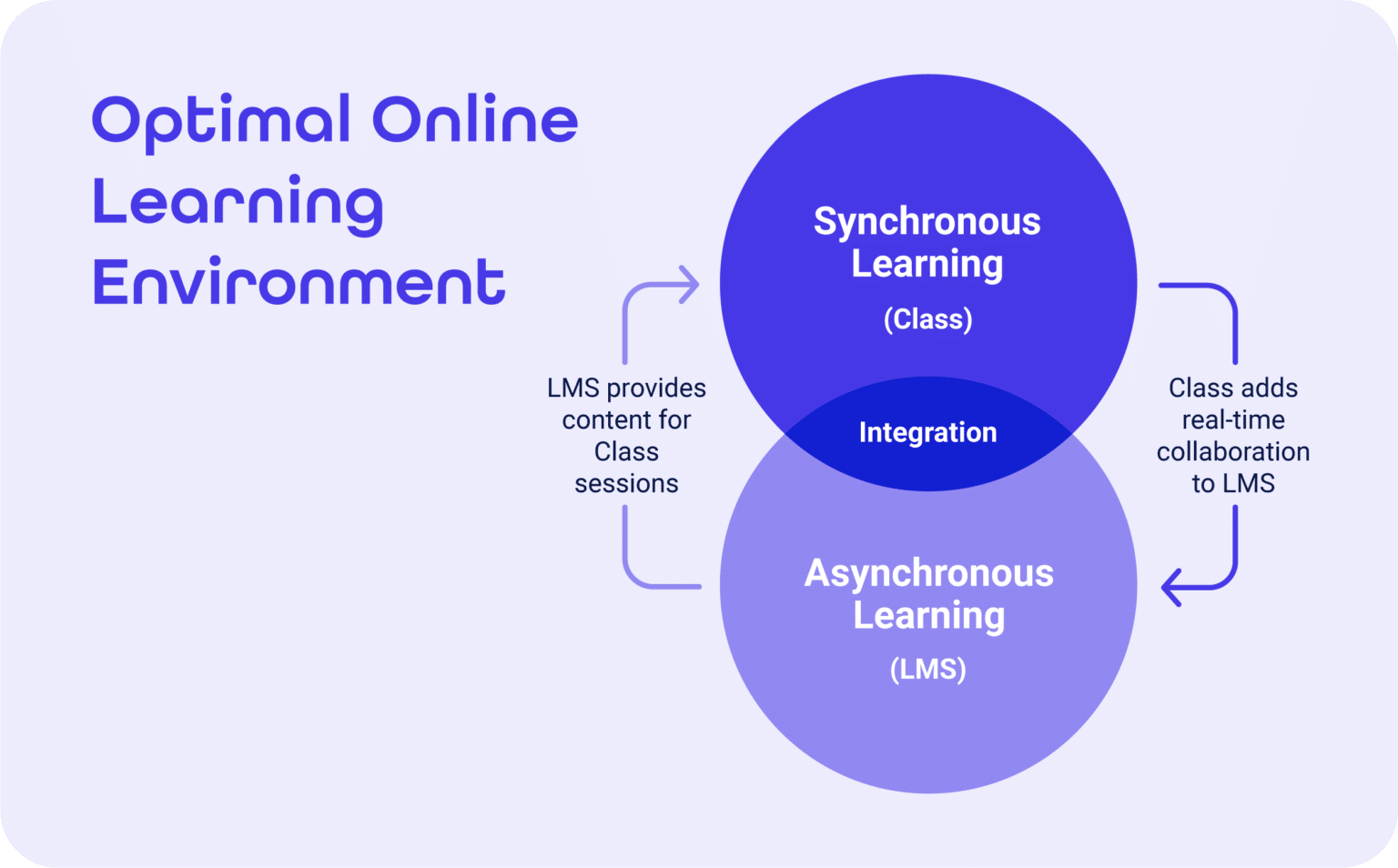
Jamie Turak is an Education Content Manager at Class. He's passionate about storytelling and helping to make education more accessible.

Jamie Turak is an Education Content Manager at Class. He's passionate about storytelling and helping to make education more accessible.

If you’re an instructor or student at a two-or-four year college, you’re likely working hand-in-mouse with a Learning Management System (LMS).
These innovative technology platforms are ubiquitous in higher education. Present at 99% of institutions, they have revolutionized the delivery of teaching and learning globally.
But what does the future of Learning Management Systems look like?
This article discusses the future of your school’s LMS alongside its evolving impact on education now and to come. Learn about their history, improvements, and how today’s technologists and educators reimagine LMSs to better equip global learners of tomorrow with the tools they need to succeed.
Jump To:
A Learning Management System (LMS) is an online software for creating, delivering, tracking and reporting educational courses, progress, and outcomes. These cloud-based platforms help educators and students across all learning modalities, supporting traditional in-person instruction, or powering hybrid and fully remote courses and programs.
LMS platforms support the whole college ecosystem. Educators manage their courseload easily while sharing materials, content, and media with students. Students post on discussion boards, review classmates’ work and stay updated on expectations and deadlines.
With 85% of faculty confirming using their institution’s LMS (2015), technology that streamlines teaching and learning across campus is longer optional but essential.
Here are a few ways schools use LMS solutions to deliver education scaled for institutional and student success.
Any LMS your school deploys should align with its institution’s learning goals. That means thoughtfully considering how your LMS and learning tech stack supports the problem or focus areas of your student body and campus. To assess whether your learning management solution is right for your institution, first consider what your institution needs most.
While education evolves, so do learning management systems.
Here are a few ways educators and technologists are imagining future iterations of your university’s primary learning tool.
While LMSs ease instructor administration, future designs focus additionally on student-centered learning.
Beyond “administrative efficiency,” educators want to leverage LMSs to support student-centric pedagogy, including content creation, collaboration, and communication. Designing for a better student-instructor learning experience amplifies your LMS to deliver higher-quality learning possibilities at your institution.
When using any learning technology, there’s a question of who’s in charge: the user or the application?
This question is important in design, and EdTech tools are no different. How creative can users get with the application? Can they do more with the application than intended, or does intention limit them?
Theorists like Lane, L.M. (2009) explore this dilemma in education, suggesting that modern LMSs could improve the expressive potential of their instructional pedagogy. Similarly, others suggest that modern LMSs overly direct the “pedagogy of the course” rather than the student.
Student-centered tech design is changing this narrative. For example, current and future LMSs combined with synchronous learning integrations amplify instructional potential by driving real-time social interactions and connections online.
While Learning Management Systems have a rich history, they’ve also changed a lot.
Some might say today’s LMSs date back to Sidney Pressery’s 1924 teaching machine, one of the first advents of education automation. Others suggest that Hewlett-Packard’s first e-learning PC and calculators in the 1970s inspired LMSs the most. Yet, like all technology–and whatever the timeline–it’s on a path to improvement.
The future of LMSs brings innovation focused on:
And while LMSs are at the forefront of innovation, so is your institution. Here are just a few exciting things the future brings.
Learning data is trending in higher education. Administrators want to make informed decisions to support student outcomes and institutional success. And the technology that empowers data-based learning now exists to help them.
Future LMS platforms will leverage analytics to generate insights to make data-driven decisions. Whether built natively into LMS solutions or integrated with other software, analytics will compute enrollment metrics, identify course success, run diagnostics, track engagement, and cluster students via assessment metrics, among other uses.
Future LMSs will leverage instructional analytics to help schools and faculty deliver personalized approaches to learning and curriculum. That means tailoring courses, pace, and materials based on the needs of different students.
Learner reports will help instructors design student-specific roadmaps. These reports will support content management and cloud-based services, where LMSs provide greater storage capabilities with algorithmic pairing for unique content and media offerings.
Today, LMSs have technological integrations that offer more learning tools for instructors and students. That means your LMS works seamlessly with emergent technology, like Class’s online synchronous learning platform, to give your institution new learning possibilities.
For example, Class maximizes active online learning with your LMS, bringing together the best of synchronous and asynchronous instruction.
Adding synchronous learning to your LMS drives social learning online. Class is now integrated with all LMSs, offering a real-time and active environment for students and instructors to collaborate. Whether through shared seminars, group projects or meetings, live chats, or shared classroom whiteboards, the future of learning online isn’t solitary but social.

Augmented and virtual reality (AR/VR) learning technologies create new pathways for students to learn in immersive instructional environments. And LMSs are trending to streamline these educational experiences.
This article from Brookings discusses some promising educational use cases, including medical school students engaging in experimental surgeries or biology students engaging with simulations of the natural world.
Your online learning program is filled with learners, interactions, and tools. And as more students learn online, they’ll call their digital ecosystem their campus.
That’s why the future of Learning Management Systems is so important. While LMSs are building blocks to higher education, they’re also the heart of any modern student learning success.
To learn more about how you can empower virtual learning with your institution’s LMS, visit us at class.com/higher-ed or schedule your demo today.

Jamie Turak is an Education Content Manager at Class. He's passionate about storytelling and helping to make education more accessible.

Jamie Turak is an Education Content Manager at Class. He's passionate about storytelling and helping to make education more accessible.
Get our insights, tips, and best practices delivered to your inbox

Sign up for a product demo today to learn how Class’s virtual classroom powers digital transformation at your organization.

Features
Products
Integrations